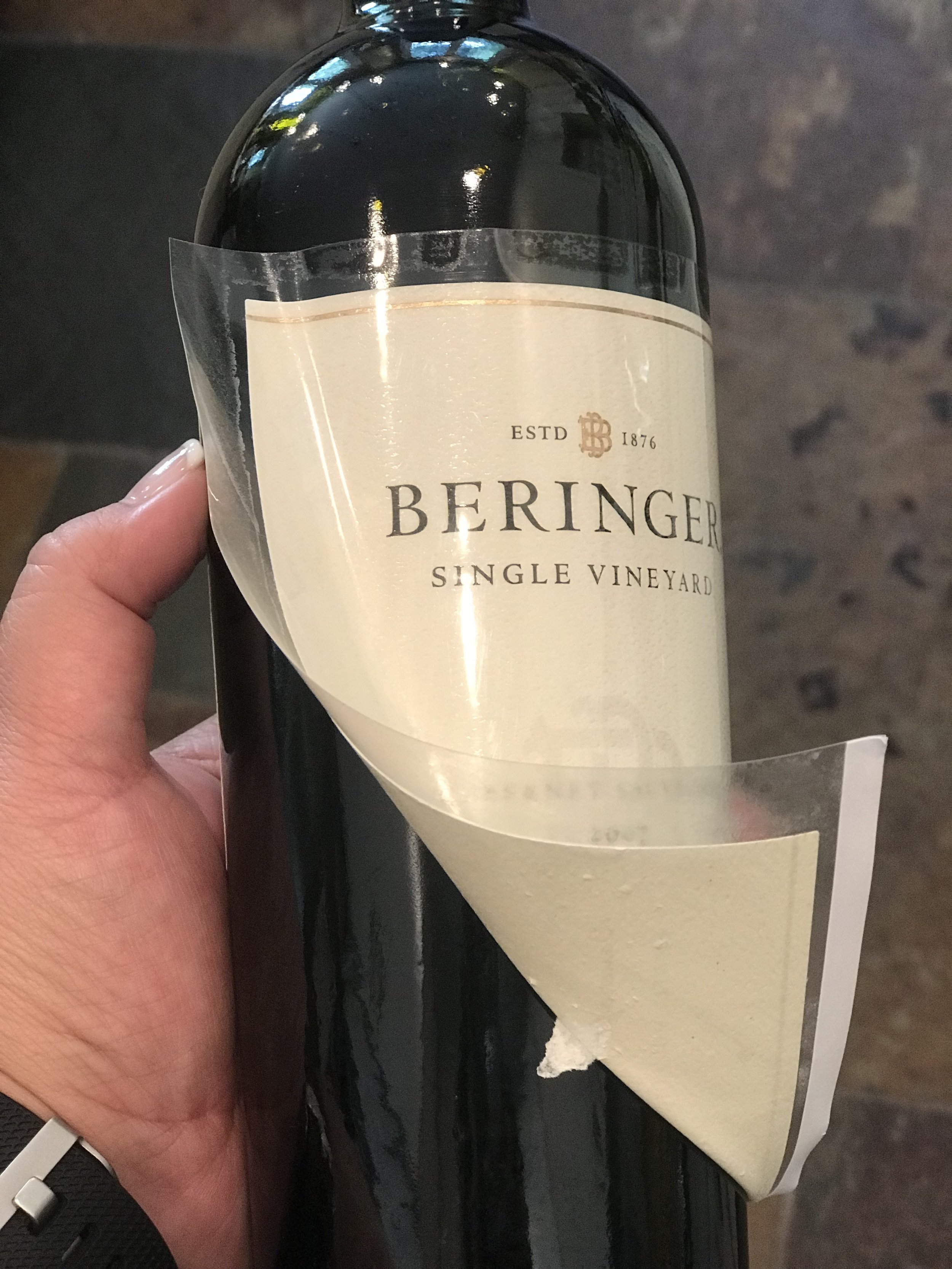If you’re a wine and craft beer enthusiast, a winemaker, or a crafter (or are just curious!), you may find yourself needing to remove wine labels from bottles. Here, we offer an overview and specific details on how to get a label off of a wine bottle for a variety of purposes. As you’ll see, there is no one-size-fits-all methodology for removing wine labels.
Before we continue our how-to, though, a little about the KnowWines blog. We are an Amazon.com affiliate and we do receive a small commission if you purchase items through our affiliate links at no cost to you. The commissions we receive help us pay for web hosting fees, products to test, our podcast, and other costs associated with running this site. Thanks for using our affiliate links and supporting our independent blog!
Why remove the label from a wine bottle?
Wine enthusiasts and scrapbookers may want to remove a wine label to save it in a wine journal or scrapbook. Private-label winemakers remove labels for the purpose of re-use - they remove commercial labels from the bottle before adhering to their own. Last, artisans and crafters often use wine bottles or wine labels for crafts such as wine bottle glassware (affiliate link), wine tile coasters (affiliate link), or framed wine labels as wall or desk art (affiliate link).
What should I consider before removing a wine bottle label?
First, remember to keep the bottle you want to remove the label from! Far too often, a wine bottle disappears from the table or from the party before one thinks to save the label. Once the bottle disappears, the only option remaining is to send a self-addressed stamped envelope (via snail-mail) to the winery or restaurant and ask if they have an extra label from that vintage. Explain that you did not keep your bottle and that you want the label for your wine journal.
Next, determine if you are able to take the bottle home with you or if you must remove the label there at the event. Not being able to take the wine bottle home will significantly reduce your options for removing a wine label. Your only options then are the Lift-Off Method and the “kindly ask your server or sommelier if they can remove the label for you” approach!
Once you have the bottle home, you’ll need to assess the label and the associated adhesive. Determining which item you wish to keep - the label or the bottle - will dictate the method of removal you use.
How do I decide the method of label removal for a particular bottle?
What is the label constructed of? If the label is plastic (more like a sticker) it will be less permeable to water. If it is plastic, then removal will often require heat or physical means (such as a razor) regardless if you are trying to save the label or just the bottle.
If the label is paper, then it is more permeable to liquids and a different removal method may be needed depending on if you are trying to save the label or the bottle.
Labels adhere to wine and beer bottles through a variety of adhesive polymers. These include pressure-sensitive adhesives (sticker-like) and water-based glues. Since many of us are not adhesive experts, we will be assessing the label using visual assessment to guess the composition of the glue and to select the label removal method with the highest likelihood of success.
To assess the adhesive construction, take a razor or knife and lift a corner about ¼ inch. If the adhesive looks like traditional glue, the use of a detergent and water-based method can be considered. If the adhesive looks more sticker-like in consistency, then heat or physical means (razor, peeling) will be your best bet.
Wet Label Removal Methods
So, the label you want to remove from the wine bottle looks to be a more conventional glue composition - these label types are typically more water-soluble.
The OxiClean Method
Based on our personal experience, as well as those in most wine and craft beer forums, we find that the most successful method is the OxiClean approach. We’ve used the OxiClean method on both paper/glue bottles as well as plastic labels with adhesive. If you don’t have Oxiclean in the house, try a comparable household cleaning product like Ajax (affiliate link) recommended by Harry in our comments section.
Here’s an effective OxiClean label removal method we found in a craft beer forum:
Fill sink (or bucket) with one gallon of water and ¼ cup Oxiclean.
Submerge the wine bottle in the liquid.
Wait thirty minutes (during which time you may as well enjoy a glass of wine!). Depending upon the adhesive, you may return to find your wine label floating in the sink intact.
Take a utility knife and slowly lift up on the edge of the label. If the label is not easy to peel off after thirty minutes of soaking, it’s not going to come off using this method without significant elbow grease. You might as well resign yourself to drying the bottle and trying a dry method.
Work the utility knife under the label at a diagonal angle. Resist the urge to use your fingers to help speed along the process, as using fingers may result in adding wrinkles to the finished product.
Place the wet label on a piece of waxed paper so that the wet adhesive does not stick to your counter
Once your label is dry, use an acid-free glue stick to adhere your label to your wine journal, your prepared coaster, or photo frame. Check out this article for making your own wine label coasters.
Other Household Cleaners to Use for Wine Label Removal
Ammonia
No OxiClean? No problem. Household ammonia (affiliate link) is another product, in combination with water, which can aid in dissolving adhesives. Instead of using ¼ cup OxiClean replace it with ¼ cup ammonia. The ammonia method, in our experience, is a little less effective than the OxyClean method.
Baking Soda
Only have baking soda (affiliate link) on hand? Add 5 to 10 tablespoons to one gallon of warm water and follow the same steps as the OxiClean method.
Hot Water
No OxiClean, no ammonia, no baking soda? Try placing the bottle in boiling water, or filling a sink with hot water and dish soap and letting the bottle sit overnight. Regardless, there is going to be some elbow grease involved to remove the adhesive residue.
Accessories for Wet Method Wine Label Removal
Regardless of your method - OxyClean, ammonia, simply hot water - if your aim is to discard the wine label and use the bottle for crafting or home winemaking, two products are indispensable.
First, you can scrape the residue with a straight razor or this slightly safer razor with a handle. If you scrape too hard, you can scratch the bottle.
You can also try a non-abrasive scrubber that is gentle and won’t scratch the wine bottle unless you apply superpower strength.
Still a little bit of adhesive? Goo Gone (affiliate link) is our go-to product for adhesive removal. After using the Goo Gone, we recommend thoroughly washing the bottle soapy water before re-using to adequately remove the Goo Gone (Goo Gone residue may interfere with your crafting products).
Dry Label Removal Method
Label Lift Method
This method is for the crowd who wants to keep the label in a wine journal or affix it to cardstock for a souvenir.
Our favorite Label Lift is the Onephile Label Lift. We’ve found that this label lift works well when following instructions - we’ve yet to come across a label that gets ripped or torn by the process.
To apply the Label Lift, simply place it over the label, rub for 1-2 minutes with the backside of a spoon or other hard object, then peel the label.
Before placing the label in the wine journal or book, you can trim the edges.
These label lifts come in packages of 10 or 50. To get the hang of it, we recommend getting your technique down with a label from a wine or beer you don’t intend to keep, or practice by first removing first the back label (which most people don’t collect).
This lift label package also fits nicely inside a notebook or wine journal for easy transport.
The one downside is that the wine label now appears laminated. If that is not a look you are going for, then try the Oven Method.
Heat (Oven) Method
So, you don’t like the idea that your wine label appears laminated after removal. Perhaps you would like to make a wine label trivet or mount the wine label onto cardstock for framing. Or maybe you collect them for eventually making a collage for your wine cellar (lucky you!). Try the heat method! You’ll need some oven mitts (affiliate link) for this one.
First, make sure there is no wine inside the bottle. Also, make sure that the foil cap or wax bottle cover is removed so there are no foul odors when heating the bottle.
Place the wine bottle on a cookie sheet (or in a baking dish so it is not rolling around in a dry oven) at 350 degrees F for 5 minutes. Remove the bottle from the oven and check the readiness of the label for removal by testing the back label. Slip a razor or knife under the label and start to peel slowly from one corner. Don’t force the label or push with your fingers as this is how labels get crinkled during removal. If the label does not give, give it another 5 minutes in the oven. If after 15 minutes the label will not come off, you will have to use another method (like the OxiClean method) as the adhesive needs to be dissolved to come off cleanly.
That’s a wrap … and a few bonus tips!
We’ve provided you with several options for removing wine labels from the bottle, whether you are wanting to keep the label or the bottle!
Removing a label from a bottle of wine is never a perfect endeavor. A little trial and error are involved in the process as well as some elbow grease.
If you don’t want to go through all this effort, here are two options:
You can ask the waiter to remove the wine label for you if you are enjoying a special bottle of wine in a restaurant.
You can send a self-addressed, stamped envelope to the winery and ask for a pristine label. They may have one available to send to you (however, it won’t, of course, be from the specific bottle you drank).
Let us know which methods you’ve used in the comments!
Cheers!





